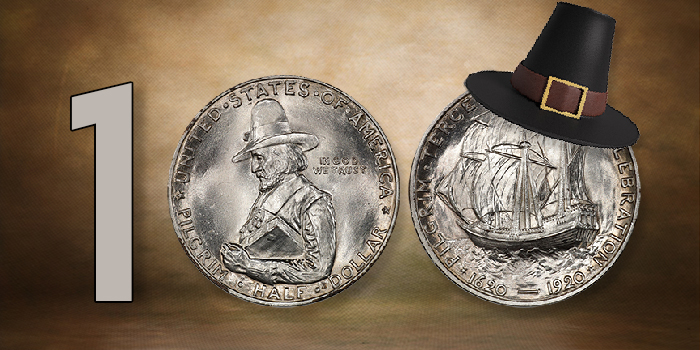
Each November, as Americans gather to celebrate Thanksgiving, numismatists have a unique way of commemorating this historical holiday, through coins, commemoratives, medals, and even rare banknotes that reflect the traditions, treaties, and journeys that mark its origins.
While the modern holiday often centers around turkey dinners and family gatherings, its deeper meaning is embedded in themes of gratitude, resilience, and cultural intersection. These same themes echo across America’s numismatic landscape, captured in striking detail through expertly designed and historically rich issues.
Thanksgiving traces its roots to 1621, when the Wampanoag people and the Pilgrims of Plymouth Colony shared a harvest meal after forging a fragile alliance amid hardship and survival. Over the centuries, this story became a cultural touchstone, and artists, engravers, and legislators alike found inspiration in its message of cooperation and hope.
The U.S. Mint and Bureau of Engraving and Printing have honored this legacy through carefully crafted imagery, from the clasped hands of a treaty on a modern dollar coin to a somber Pilgrim ship departure on a century-old currency note.
For collectors, Thanksgiving-themed numismatics offer more than aesthetic appeal, they serve as tangible connections to our national narrative. Whether in silver, bronze, or inked paper, these pieces are windows into the values and struggles of a young and evolving country.
Below are four numismatic pieces that embody the spirit of Thanksgiving.
2011 Native American $1 Coin – Wampanoag Treaty
The 2011 issue of the Native American $1 Coin series commemorates one of the most significant events leading to the first Thanksgiving: the 1621 treaty between the Wampanoag people and the Pilgrims of Plymouth Colony.
The reverse design features the crossed hands of Governor John Carver and Massasoit, the Wampanoag chief, symbolizing their mutual pledge of peace and cooperation.
This treaty was the first formal written agreement between colonists and Native Americans, laying the groundwork for what would become a fragile but foundational relationship in colonial America.
While many Thanksgiving portrayals romanticize this event, the coin brings a solemn recognition of diplomacy and shared survival.
Highlights:
- Designer: Richard Masters (Reverse), Phebe Hemphill (Sculptor)
- Obverse: Sacagawea with child (series standard)
- Reverse: Hands clasped in alliance, with “WAMPANOAG TREATY 1621”
- Issued in: Satin Mint and Business Strike versions
- Edge Lettering: “E PLURIBUS UNUM” and date
The coin challenges us to consider the broader story of Thanksgiving, not just one of celebration, but of fragile trust and early nation-building.
Pilgrim Tercentenary Half Dollar (1920 & 1921)
Authorized by Congress in 1919, this classic commemorative half dollar marked the 300th anniversary of the Pilgrims’ landing at Plymouth in 1620. Minted in both 1920 and 1921, it holds the distinction of being one of the earliest U.S. commemoratives and the only coin directly tied to the Thanksgiving origin story.
The obverse features Governor William Bradford, a key Pilgrim leader, holding a Bible, symbolizing religious freedom and spiritual guidance.
The reverse depicts the Mayflower, the ship that carried the Pilgrims across the Atlantic. Its dramatic profile slicing through stylized waves stands as a powerful metaphor for perseverance and destiny.
Originally intended as a fundraiser for the Pilgrim Tercentenary Commission, many coins remained unsold and were later returned and melted, making pristine examples more collectible today.
Highlights:
- Designer: Cyrus E. Dallin
- Obverse: Portrait of Governor Bradford
- Reverse: The Mayflower ship
- 1920 Mintage: ~152,000; 1921 Mintage: ~20,000
- Legal Tender: Yes (50¢), though never widely circulated
- Metal: 90% silver
This coin captures a monumental moment in American heritage, the search for religious freedom, early colonial hardship, and the seeds of Thanksgiving itself.
2020-W Gold $10 Mayflower 400th Anniversary Reverse Proof

To commemorate the 400th anniversary of the Mayflower’s historic 1620 voyage, the United States Mint released an elegant $10 gold coin struck in Reverse Proof finish at the West Point Mint.
The obverse depicts a Wampanoag family on the shoreline of what is now Massachusetts, known as Patuxet to the native population, as they witness the arrival of the Mayflower from foreign shores.
The reverse features portraits of a Pilgrim man and woman looking forward toward their future in the New World, symbolizing the transition towards a democratic society. A pair of mayflower blossoms flank the design.
This coin was struck in .9999 fine 24-karat gold and released in a limited mintage, offering both collectors and historians a richly symbolic artifact of America’s early colonial story. The reverse proof finish enhances its artistic depth, giving a soft, frosted foreground and polished background that highlight the emotional storytelling.
Highlights:
- Denomination: $10 (face value)
- Composition: 1/4 oz. .9999 fine gold
- Finish: Reverse Proof
- Mint: West Point (W mint mark)
- Mintage Limit: 5,000 (individual issue)
Unlike traditional commemoratives, the 2020-W gold $10 coin breaks new ground in both design and symbolism.
1918 $10,000 Federal Reserve Note – “Embarkation of the Pilgrims”

Among the most majestic and elusive pieces of American currency is the 1918 $10,000 Federal Reserve Note, issued exclusively for interbank transfers. While this note was never intended for public circulation, it features one of the most historically and emotionally resonant Thanksgiving-themed vignettes ever engraved on U.S. paper money.
The reverse design is based on Robert W. Weir’s iconic 1844 painting, “Embarkation of the Pilgrims,” which hangs in the U.S. Capitol Rotunda. This scene depicts the Pilgrims aboard the Speedwell, gathered in solemn prayer and reflection before departing Holland for the New World in 1620. It’s an intimate and poignant rendering of faith, courage, and thanksgiving, an overt spiritual moment that serves as a prelude to the holiday we now commemorate.
The engraving captures Governor John Carver, Elder William Brewster, and others, hands clasped, heads bowed, illuminated by the symbolic Light of Divine Providence shining through the ship’s window.
The level of detail is masterful, thanks to the expert hand of U.S. Bureau of Engraving and Printing artisans, making it not only a rare note, but a museum-worthy work of numismatic art.
Highlights:
- Series: 1918 Federal Reserve Note
- Denomination: $10,000
- Usage: For internal U.S. Treasury and Federal Reserve Bank transactions only
- Reverse Design: “Embarkation of the Pilgrims,” after Robert W. Weir
- Obverse: Portrait of Salmon P. Chase, U.S. Treasury Secretary and Chief Justice
- Engraving Detail: Exceptional classical realism with historical fidelity
- Rarity: Extremely scarce; most specimens reside in institutions
Though practically unobtainable, the 1918 $10,000 note offers a powerful lens into the spiritual legacy of Thanksgiving, reminding us that before the feast came faith, and before the harvest came the voyage.
The post Thanksgiving Day Reflections Through Numismatics appeared first on CoinWeek: Rare Coin, Currency, and Bullion News for Collectors.
VarietyErrors
Sign up for FREE News, Videos and Articles!



